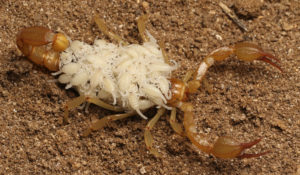On an early spring morning, she slowly climbed the long, slender grass stem hanging over a well-used trail. After reaching the top, she clung precariously but firmly, front legs outstretched, ready to grab anything that came near. And that was her goal. Grab a free ride and get a free meal. That evening a raccoon ambled down the trail sniffing here and there for a tasty morsel, but he passed inches to the left of her swaying perch. As the cool spring day wore on, a gray fox, a coyote, a bobcat, and a pair of spotted fawns passed by on the trail, but just out of reach. Finally, two days later, a young black-tailed deer came so close that she could sense the warmth of his body and the carbon dioxide of his breath. As the deer brushed against the blade of grass, she grabbed onto his stiff hairs. Dinner would soon be served.
Because members of her species have black legs and live in western states, the species was given the name western black-legged tick. Her body was a deep blood-red color, and she was only slightly larger than a fly’s eye, but she was as tough as they come, and with a good meal, she would bloat up six or more times in size.
- A western black-legged tick clings to a blade of grass, awaiting its next meal. Photo (c) Dan Suzio, dansuzio.com.
Crawling deep into the deer’s fur, she used her sharp cutting “teeth” (called chelicerae) to cut a hole in his skin and inserted her barbed snout. The barbs would make it difficult for her to be scratched or bitten loose, but she went one step further and used a secretion to cement herself to the deer. Before starting on her meal of blood, she injected saliva containing an anesthetic, anticoagulants, blood vessel dilators, and digestive enzymes. If her body contained disease organisms, such as Lyme disease, they would enter the deer’s body. She had no such diseases now, but earlier in her life she did.
Two years before, her mother had laid over a thousand eggs in some leaf litter. Most did not survive to adulthood. The lucky ones attached to birds, reptiles, and small mammals. As a tiny larva, she found a deer mouse as her first host. The mouse’s blood contained Lyme disease bacteria, and as she drank, the bacteria entered her body. She dropped off the mouse and molted into a nymph, and she found her next meal under the scales of a western fence lizard. But then a strange thing happened. While sucking the lizard’s blood she also injected some of the Lyme disease bacteria into the lizard. Amazingly, all the disease organisms entering the lizard died, and when she sucked the lizard’s blood, the Lyme bacteria in her own body were killed.
One of her sisters had gotten a ride and avian blood to eat after she attached herself to a robin. After a three-day trip, she dropped off and later molted into an adult. She also climbed a grass stalk along a trail and eventually found a bare-legged Boy Scout to attach to. The next morning, the boy complained of a sharp pain on the back of his neck. The scout leader found a tiny tick dug in well. He recognized it as a western black-legged tick and removed it carefully with tweezers. He told the boy’s mother that the boy should see a doctor because the tick could carry Lyme disease. The boy learned that the disease starts with a rash and flu-like symptoms, and untreated Lyme disease could cause facial paralysis, chronic arthritis, fatigue, and memory loss. Though the incidence of Lyme disease in deer ticks, an eastern species that carries the disease, can be as high as 60 percent, the incidence in Bay Area ticks seldom goes above 5 percent, thanks to fence lizards.
As for our tick, after a week’s worth of drinking deer blood and swelling to the size of a salmon egg, she dropped off, waddled into the woods, and laid over 900 eggs. Her life was near its end, but soon her eggs would hatch and tough, tenacious little larvae would take her place in the web of life.
Find more tick information here.

.jpg)




